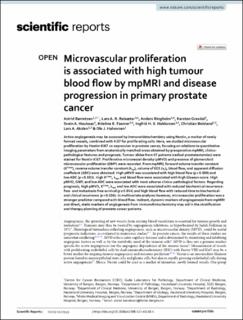Microvascular proliferation is associated with high tumour blood flow by mpMRI and disease progression in primary prostate cancer
| dc.contributor.author | Børretzen, Astrid | |
| dc.contributor.author | Reisæter, Lars Anders Rokne | |
| dc.contributor.author | Ringheim, Anders | |
| dc.contributor.author | Gravdal, Karsten | |
| dc.contributor.author | Haukaas, Svein Andreas | |
| dc.contributor.author | Fasmer, Kristine Eldevik | |
| dc.contributor.author | Haldorsen, Ingfrid S. | |
| dc.contributor.author | Beisland, Christian | |
| dc.contributor.author | Akslen, Lars Andreas | |
| dc.contributor.author | Halvorsen, Ole Johan | |
| dc.date.accessioned | 2024-04-17T13:09:36Z | |
| dc.date.available | 2024-04-17T13:09:36Z | |
| dc.date.created | 2023-11-09T09:32:39Z | |
| dc.date.issued | 2023 | |
| dc.identifier.issn | 2045-2322 | |
| dc.identifier.uri | https://hdl.handle.net/11250/3127072 | |
| dc.description.abstract | Active angiogenesis may be assessed by immunohistochemistry using Nestin, a marker of newly formed vessels, combined with Ki67 for proliferating cells. Here, we studied microvascular proliferation by Nestin-Ki67 co-expression in prostate cancer, focusing on relations to quantitative imaging parameters from anatomically matched areas obtained by preoperative mpMRI, clinico-pathological features and prognosis. Tumour slides from 67 patients (radical prostatectomies) were stained for Nestin-Ki67. Proliferative microvessel density (pMVD) and presence of glomeruloid microvascular proliferation (GMP) were recorded. From mpMRI, forward volume transfer constant (Ktrans), reverse volume transfer constant (kep), volume of EES (ve), blood flow, and apparent diffusion coefficient (ADC) were obtained. High pMVD was associated with high blood flow (p = 0.008) and low ADC (p = 0.032). High Ktrans, kep, and blood flow were associated with high Gleason score. High pMVD, GMP, and low ADC were associated with most adverse clinico-pathological factors. Regarding prognosis, high pMVD, Ktrans, kep, and low ADC were associated with reduced biochemical recurrence-free- and metastasis-free survival (p ≤ 0.044) and high blood flow with reduced time to biochemical- and clinical recurrence (p < 0.026). In multivariate analyses however, microvascular proliferation was a stronger predictor compared with blood flow. Indirect, dynamic markers of angiogenesis from mpMRI and direct, static markers of angiogenesis from immunohistochemistry may aid in the stratification and therapy planning of prostate cancer patients. | en_US |
| dc.language.iso | eng | en_US |
| dc.publisher | Springer Nature | en_US |
| dc.rights | Navngivelse 4.0 Internasjonal | * |
| dc.rights.uri | http://creativecommons.org/licenses/by/4.0/deed.no | * |
| dc.title | Microvascular proliferation is associated with high tumour blood flow by mpMRI and disease progression in primary prostate cancer | en_US |
| dc.type | Journal article | en_US |
| dc.type | Peer reviewed | en_US |
| dc.description.version | publishedVersion | en_US |
| dc.rights.holder | Copyright 2023 the authors | en_US |
| dc.source.articlenumber | 17949 | en_US |
| cristin.ispublished | true | |
| cristin.fulltext | original | |
| cristin.qualitycode | 1 | |
| dc.identifier.doi | 10.1038/s41598-023-45158-4 | |
| dc.identifier.cristin | 2194371 | |
| dc.source.journal | Scientific Reports | en_US |
| dc.identifier.citation | Scientific Reports. 2023, 13, 17949. | en_US |
| dc.source.volume | 13 | en_US |
Tilhørende fil(er)
Denne innførselen finnes i følgende samling(er)
-
Department of Clinical Medicine [2057]
-
Registrations from Cristin [9690]

